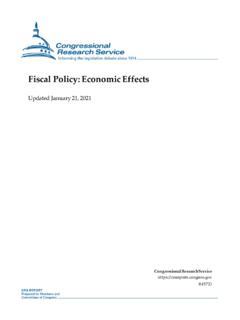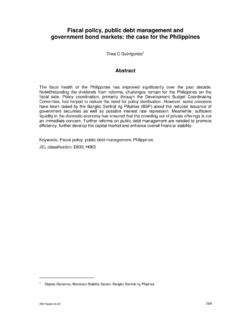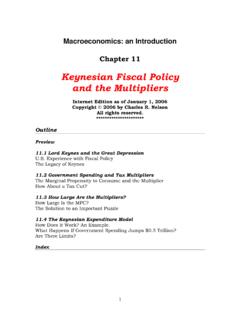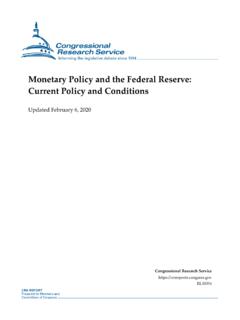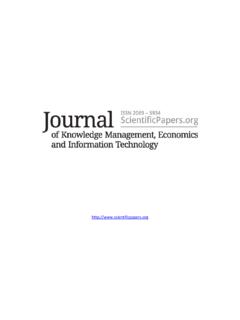Transcription of China’s monetary and fiscal policy
1 China s monetary and fiscal policy Li Ruogu In the past few years, the Chinese government has been pursuing an active fiscal policy to finance key construction projects by issuing government debt. Meanwhile, sound monetary policy has been implemented in coordination with the fiscal policy . With the coordination of the two policies, the trend of deflation has been contained, economic restructuring accelerated and economic growth further promoted. China s GDP exceeded RMB 10 trillion in 2002 - a historic breakthrough. In recent years, reform of the fiscal revenue system has resulted in the steady growth of government revenue. In 2001, it amounted to RMB trillion, times that in 1990. The proportion of government revenue to GDP increased from 11% in 1994 - during the early stage of reform - to 17% in 2001. Significant progress has also been made in reforming the management of government expenditure. Despite the above achievements, there remain challenges facing China s economic development, which are mainly reflected in the slowdown of government revenue since the beginning of 2002, the relatively high proportion of non-performing loans in the financial sector, weaker demand in rural areas and persistent employment pressure.
2 In addition, uncertainties over the global economic outlook have had an impact on China s exports and economic growth. To resolve these problems, the Chinese government will continue to boost domestic demand through proactive fiscal policy and sound monetary policy and further speed up economic restructuring and improve the quality and efficiency of economic growth. Major developments in recent fiscal and monetary policies are as follows. monetary policy Since the beginning of 2002, the People s Bank of China (PBC) has been pursuing sound monetary policy while promoting policy efficiency. The indirect policy instruments and mechanism have been improved. During the year to September 2002, China s broad money (M2) and narrow money (M1) increased by and respectively. China s base money has increased steadily and financial institutions positions remain adequate. At the end of September 2002, the central bank s base money stood at RMB trillion, representing an annual growth rate of , an acceleration of percentage points from a year earlier.
3 The average excess reserve ratio of the financial institutions was , representing an adequate position and high liquidity. The loans granted by China s financial institutions have also grown rapidly, with improvements in lending structure and quality. On a comparable basis, renminbi loans by all financial institutions (including foreign institutions) increased by , accelerating by percentage points from end-2001 and registering the highest growth since March 2001. In the light of the current situation at home and abroad, the PBC will: use monetary policy instruments in a flexible manner to adjust money supply appropriately and maintain reasonable growth in credit aggregates; promote the reform of the interest rate mechanism, and bring interest rates into full play in adjustment of the demand and supply of funds, as well as in the optimisation of resource allocation; improve the incentives applying to lending and corporate governance of commercial banks; and improve the RMB exchange rate formation system under the precondition of preserving the stability of the RMB exchange rate.
4 BIS Papers No 20 107 108 BIS Papers No 20 fiscal policy In the light of the weak global recovery in early 2002, the Chinese government continued to pursue a proactive fiscal policy to boost domestic demand. In the first three quarters, fiscal revenue increased by and expenditure by , which is under the budget limits. Owing to the slowing revenue and increasing expenditure, there is little room for further fiscal deficit reduction. The slowing revenue is caused by the following factors: customs tariffs were reduced from to 12% in line with China s WTO commitment; the impact of lowering the securities stamp tax rate became increasingly evident in 2002; the banking and insurance business tax was further lowered by 1 percentage point in 2002. The increase in expenditures is caused by the following factors: continued investment in projects funded by government bonds, western region development and technical innovation; more resources directed to the social safety net; wage increases for civil servants; increased investment in agriculture, science and education.
5 Therefore, the budget deficit in 2002 will remain at the level of of GDP. While paying close attention to the explicit risks posed by the increase in the fiscal deficit and public debt, the Chinese government is also aware of the implicit fiscal liabilities arising from non-performing loans in the banking sector, the restructuring of state-owned enterprises, and the underfunded pension system. Efforts will be made to address the medium-term fiscal risks by implementing a medium-term budgetary framework and promoting various reforms, including the overhaul of the financial system, the state-owned enterprises and the social safety net. We firmly believe that China s medium-term fiscal sustainability is strongly underpinned by sustained economic growth and a steady increase in revenue as well as the people s confidence in the government. Coordination between monetary policy and fiscal policy monetary and fiscal policy must be well coordinated.
6 This is particularly relevant to the bond market, especially the government bond market, since it has become one of the most important channels for the central bank to adjust the money supply. Currently, with base money standing at RMB 3 trillion, and outstanding government debts at only RMB 2 trillion, the volume of bonds is insufficient to satisfy the operational needs of the central bank s monetary policy . Outstanding debts, consisting of long- and medium-term debts and almost no short-term ones, will also affect the efficiency of the central bank s monetary operations. Furthermore, the products in the bond market lack diversity. Under these circumstances, it will be hard for the central bank when conducting open market operations to take into consideration the interests of all the parties involved. Therefore, coordination and communication between the central bank and the Ministry of Finance are necessary in formulating and implementing macroeconomic policies.
7










